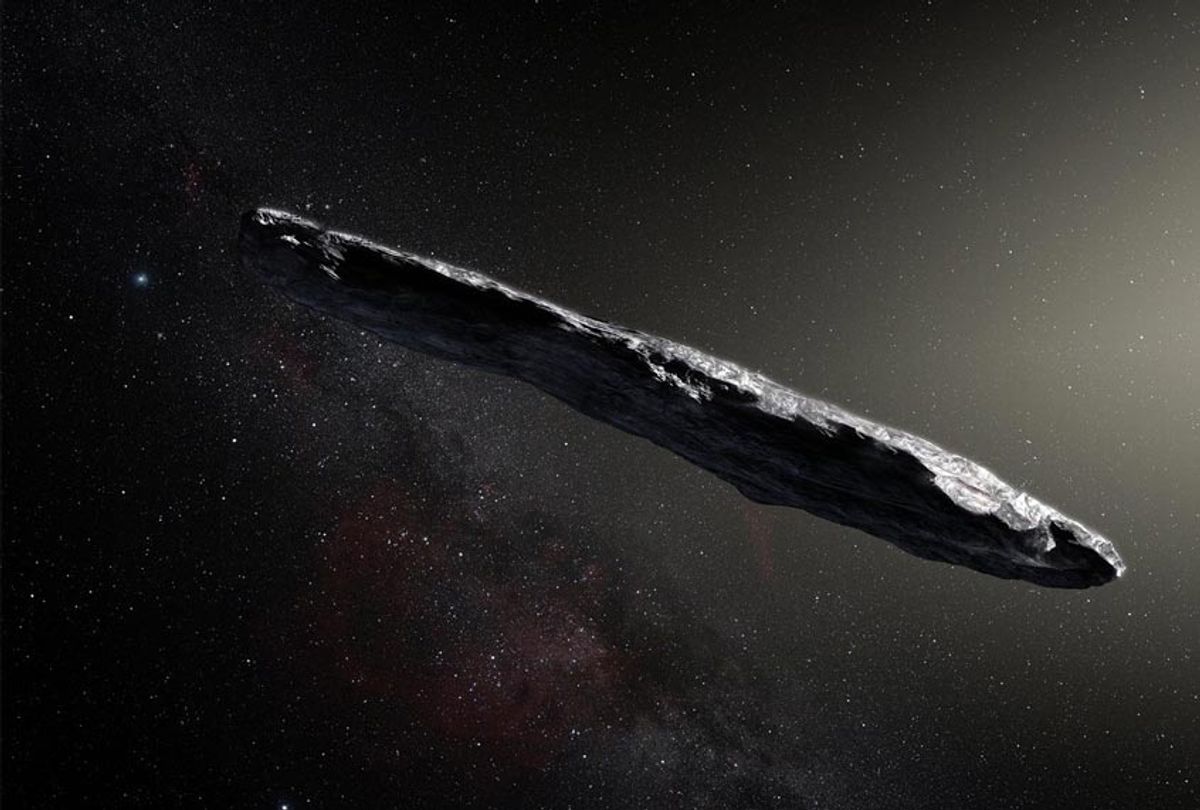When 'Oumuamua jetted past Earth on its trip through our solar system, its unique shape and swift speed grabbed the attention of scientists around the world. Partly because the mammoth, cigar-shaped rock that swung in and out of our solar system in October 2017 had some strange properties which suggested it could be an alien spacecraft. Was this the moment that humanity would confirm the existence of extraterrestrial life?
Some scientists believed so.
Unfortunately for the Fox Mulders of the world, new research published in the journal Nature Astronomy on Monday, which conducted a deep analysis on existing data — including a December 2017 study of 'Oumuamua's shape and spin pattern — says it is highly unlikely 'Oumuamua was an alien spacecraft. Instead, the paper says evidence strongly suggests 'Oumuamua has a natural origin, and was not the technological product of an alien civilization.
"We have never seen anything like 'Oumuamua in our solar system. It's really a mystery still," Matthew Knight, an associate research scientist in the University of Maryland Department of Astronomy, who co-lead the analysis, said in a media statement. "But our preference is to stick with analogs we know, unless or until we find something unique. The alien spacecraft hypothesis is a fun idea, but our analysis suggests there is a whole host of natural phenomena that could explain it."
‘Oumuamua, which is Hawaiian for "an object from afar," was first observed in October 2017 by a postdoctoral researcher at the University of Hawaii who was sifting through the data stream from the Pan-STARRS astronomical survey of the sky. The researcher noticed the object was shaped like a stick, with a long axis 10 times longer than its short axis. Researchers suggested its shape would minimize abrasions from interstellar gas and dust, thus being an ideal shape for an interstellar spacecraft. Researchers landed on the otherworldly conclusion by focusing on its unexpected acceleration trajectory after swinging past the sun, which suggested it was propelled by sunlight. Since there were no observed signs of cometary activity — such as a cometary tail, or gas emission absorption lines — the possibility it could have been a comet was ruled out in a May 2018 paper by Harvard researchers.
Knight and his colleagues agreed with this in their study.
"The motion of 'Oumuamua didn't simply follow gravity along a parabolic orbit as we would expect from an asteroid," Knight said. "But visually, it hasn't ever displayed any of the cometlike characteristics we'd expect. There is no discernable coma — the cloud of ice, dust and gas that surrounds active comets — nor a dust tail or gas jets."
Knight said based on the analysis, other natural occurrences aside from it being a comet could explain its strange features.
"We put together a strong team of experts in various different areas of work on 'Oumuamua. This cross-pollination led to the first comprehensive analysis and the best big-picture summary to date of what we know about the object," Knight explained. "We tend to assume that the physical processes we observe here, close to home, are universal. And we haven't yet seen anything like 'Oumuamua in our solar system. This thing is weird and admittedly hard to explain, but that doesn't exclude other natural phenomena that could explain it."
The research team considered the different ways ‘Oumuamua could have ended up in our solar system. One theory is that it is possible that the object was in a system with a gas giant planet orbiting a star and the orbit could have ejected ‘Oumuamua into our solar system.
If this is the case, it is possible ‘Oumuamua was not an anomaly, but rather just the beginning of a new class of strange objects that we will hopefully soon learn more about.
"In the next 10 years, we expect to begin seeing more objects like 'Oumuamua. The LSST [Large Synoptic Survey Telescope] will be leaps and bounds beyond any other survey we have in terms of capability to find small interstellar visitors," Knight said. "We may start seeing a new object every year. That's when we'll start to know whether 'Oumuamua is weird, or common.”
For true E.T. believers, though, there is a small sliver of hope.
“If we find 10-20 of these things and 'Oumuamua still looks unusual, we'll have to reexamine our explanations,” Knight said.



Shares